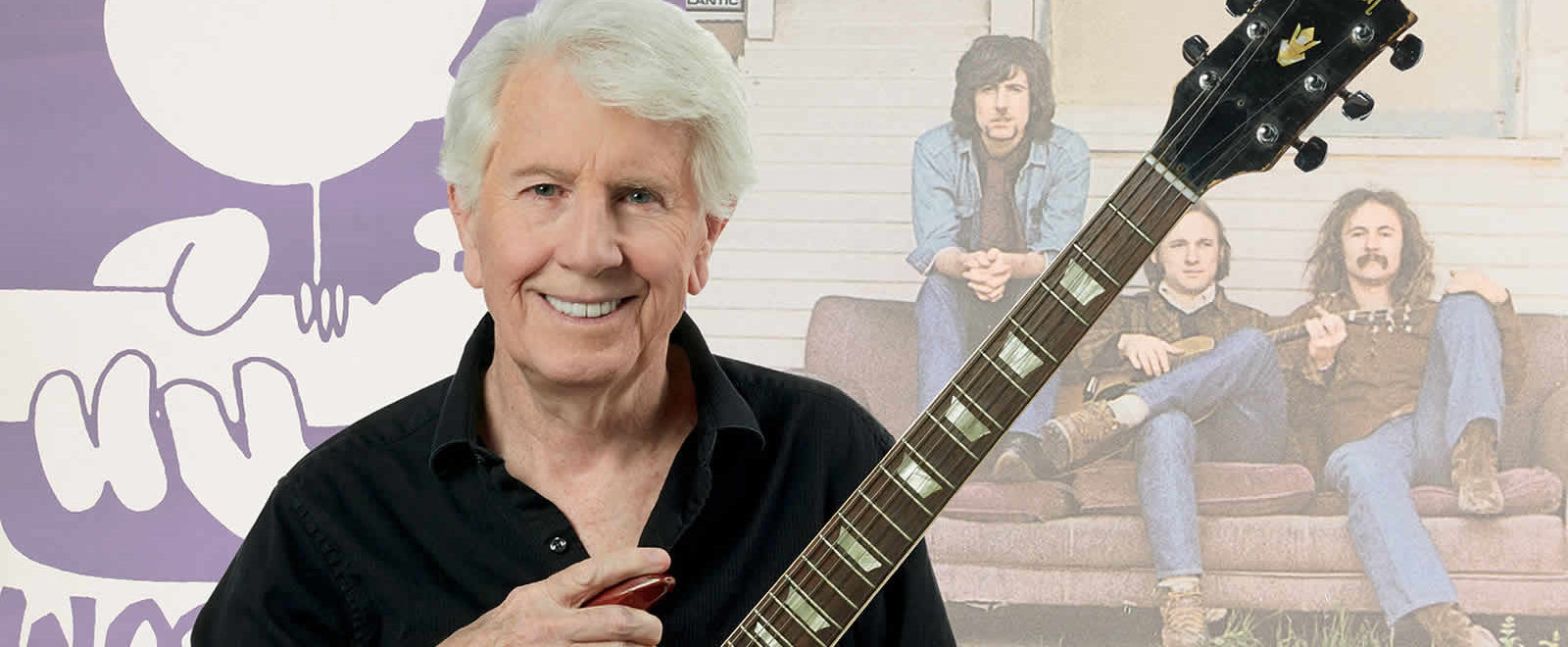REFLECTING ON HIS LEGENDARY CAREER, SINGER/SONGWRITER EXPLAINS HOW HIS GUITAR COLLECTION TAKES HIM ‘AS CLOSE TO THE FLAME AS I CAN GET’
By Hector Cantú
Graham Nash couldn’t have a bike. So he got a guitar instead.
The future Rock and Roll Hall of Famer was celebrating his 13th birthday in post-war England when his mum said the family couldn’t afford a bike. “She said, ‘What’s your second choice?’ and I said, ‘Yeah, I’d like a guitar.’”
EVENT
ENTERTAINMENT SIGNATURE® AUCTION 7201
July 20, 2019
Live: Dallas
Online: HA.com/7201a
INQUIRIES
Kathleen Guzman
212.486.3515
KathleenG@HA.com
Garry Shrum
214.409.1585
GarryS@HA.com
VIDEO: NASH OPENS UP
Graham Nash talks about collecting the guitars he’s offering at auction. Visit HA.com/GrahamNashCollection.
It was 1955, Nash recalls, “and I’d never played, but American rock ’n’ roll was just coming in, skiffle music. I think the guitar was about 5 pounds, about $10. I can’t even remember the name of the guitar. The next guitar I got was with [childhood friend] Allan Clarke. It was a Levin. We were, of course, the Levin Brothers, just like the Everly Brothers.”
By 1962, Nash and Clarke had formed the Hollies, the pioneering English group known for their distinctive three-part vocal harmonies. They became one of the leading British bands of the 1960s and achieved U.S. chart success in 1966 with their hit Bus Stop. Nash left the group in 1968 to form the super-group Crosby, Stills & Nash, a lineup that occasionally included Neil Young.
Each of the members had already made their marks in successful bands, Nash in the Hollies, Stills and Young in Buffalo Springfield, and Crosby with the Byrds. But together, “their harmonies were transcendent,” notes the book CSNY: Crosby, Stills, Nash and Young by music historian Peter Doggett. More than any of their eminent peers, the band “channeled and broadcast all the radical anger, romantic idealism and generational angst of their time.”
In recent years, Nash has focused on his solo career, releasing This Path Tonight in 2016. Last year, Rhino Records released Over The Years, a 30-track collection of Nash’s demos from 1968 to 1980, including highlights from the CSN’s debut album (Marrakesh Express), and the CSNY follow-up Déjà Vu (Our House, Teach Your Children). His 2013 autobiography Wild Tales: A Rock & Roll Life has been called “a candid and riveting autobiography that belongs on the reading list of every classic rock fan.”
Enlarge

Along the way, Nash has always been a collector, acquiring fine art, photography and guitars played by his musical heroes. His collection includes more than 80 pieces once owned by legends such as Duane Allman, Bo Diddley, Charlie Gracie, the Everly Brothers, Johnny Cash, Willie Nelson and Sam Cooke. A selection of guitars from the Nash collection is being offered at Heritage’s upcoming entertainment auction. “It’s time to let go,” says Nash, 77. The singer/songwriter is also making available to fans guitars used by CSN&Y, such as Stills’ Gretsch and Gibson, and Nash’s Fender 1950 Broadcaster and the Martin D-45 he played at the band’s 1969 Woodstock performance.
Nash has a simple explanation for the passion that drives his guitar collecting.
“I like being close to the fire. I like holding Duane Allman’s guitar. I like holding Don Everly’s guitar. It’s as close as I can get to Don without Don sitting there in front of me. It’s been played on all these incredible records and you can feel it. I just don’t collect any guitars. I’ve always collected only what touches me. It’s as close to the flame as I can get.”
Nash sat down with The Intelligent Collector to talk about some of the 19 remarkable guitars being offered at auction.
Enlarge

Opening bid: $125,000
From the Graham Nash Collection
Duane Allman’s 1961 Gibson Les Paul SG
When Duane Allman died from injuries suffered in a 1971 motorcycle crash, the decision was made to bury his favorite guitar with him, Nash says.
“At the last minute, I think it was [brother] Gregg who said, ‘No, this doesn’t feel right. Why don’t we give it to Duane’s best student?’ because Duane taught people to play slide guitar. There’s a guy named Gerry Groom and he was a brilliant guitar player, because Duane taught him, so he ended up with the guitar.”
Groom, after suffering a hand injury, Nash says, later sold the guitar to a Los Angeles music store operated by Fred Walecki. “So one day Fred called me and said, ‘I’ve got this guitar you should see.’ So I went down there and there was Duane’s guitar. I know it was his favorite guitar and he played hundreds of shows with the Allman Brothers with that guitar.”
The guitar is part of the Metropolitan Museum of Art’s “Play It Loud: Instruments of Rock and Roll” exhibit, running April 8 to Oct. 1, 2019.
Enlarge
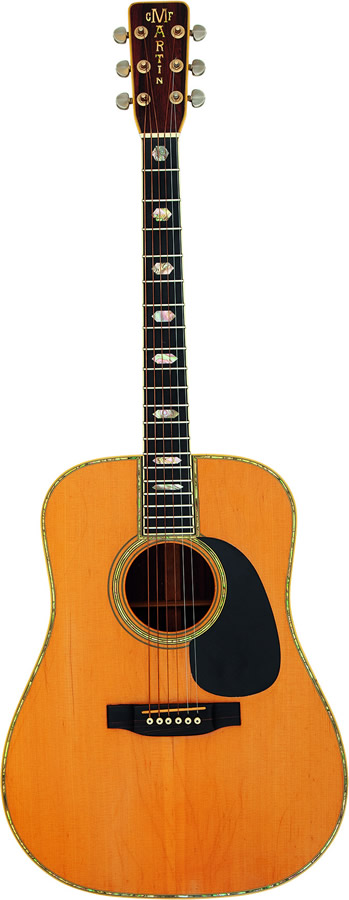
Opening bid: $60,000
From the Graham Nash Collection
Nash’s Woodstock 1969 Martin D-45
Shortly after arriving in Los Angeles, Nash met up with David Crosby and Stephen Stills at Joni Mitchell’s house. “The Buffalo Springfield had broken up and the Byrds had thrown David out,” says Nash, nicknamed “Willy” by his friends. “So David and Stephen were trying to be like the Everly Brothers and they’d been working on a song. So David tells Stephen, ‘Play Willy that song,’ a song called You Don’t Have to Cry.” Moments later, Nash joined in, harmonizing with Stills and Crosby. “We had to stop singing 45 seconds into the song because what we had created by blending our three voices into one voice was something that none of us had ever heard.”
When legendary Atlantic Records executive Ahmet Ertegun heard the song, the trio got a record deal and Crosby, Stills & Nash was born. “So we had money and the first thing you do when you have money, you want to buy better equipment,” Nash says. “We each bought D-45s from Martin. That was 1969, and so right before Woodstock, we bought these guitars and took them to Woodstock.”
Their Woodstock appearance in the early morning of Aug. 18, 1969, was only the band’s second public performance. “The reason I don’t have a picture of me playing that guitar [at Woodstock] is because for some reason Neil told everybody they couldn’t photograph us,” Nash says, before adding with a smile, “Neil’s my strangest friend.”
Enlarge
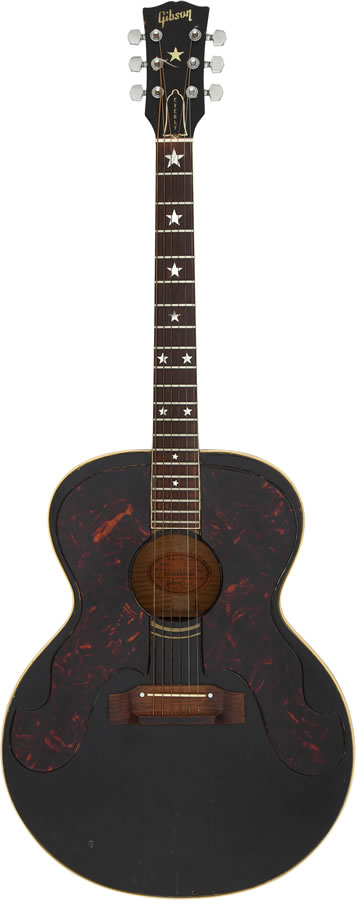
Opening bid: $12,000
From the Graham Nash Collection
Don Everly’s 1963 Gibson J-180
Nash fondly recalls when the Everly Brothers played Manchester in 1962. The duo was an international sensation, with hits like So Sad (To Watch Good Love Go Bad), Walk Right Back, Crying in the Rain and When Will I Be Loved. “Me and [Hollies co-founder] Allan Clarke decide that not only are we going to see the show, but we want to meet them.”
The best hotel in town was 100 yards from the venue, so Nash and Clarke sat on the hotel steps and waited. “At about 1:20 in the morning, they came around the corner and on the steps are me and Allan. They treated me like a human being! They called me Graham. They called Allan Allan. We say we sing, we say we want to be like you, we want to make records.”
Enlarge
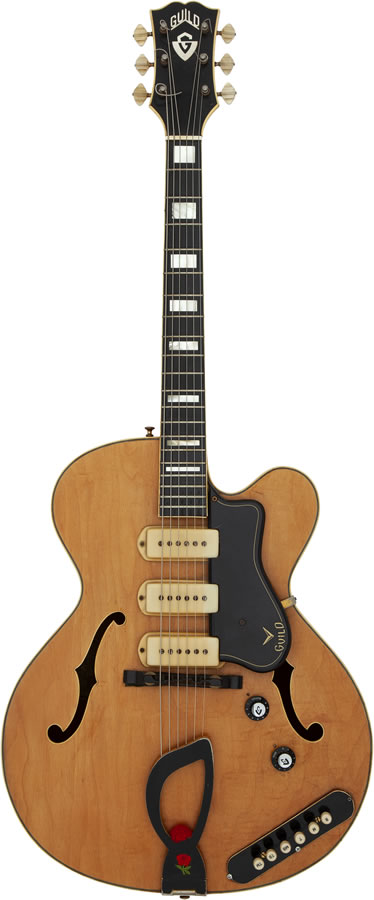
Opening bid: $20,000
From the Graham Nash Collection
Four years later, the Hollies are performing at the London Palladium when, during the sound check, the phone rings backstage. “The Hollies’ road manager picks it up,” Nash says, “and he hands it to me and says, ‘It’s Phil Everly. I picked up the phone, and he says. ‘Hey, Graham, it’s Phil,’ and I go ‘Wow. OK. Great. Why are you calling me?’ He says, ‘Well, we’re in England to make a record. Do the Hollies have any songs?’ We were writing constantly. We had about a dozen songs we hadn’t recorded, so we go down to their hotel and we play these songs and they choose seven of them and the next day we’re recording with the Everly Brothers singing our songs!
“So that’s why I have this guitar [Don Everly’s 1961 Gibson J-180],” Nash says, adding it was acquired from rare music dealer Fred Walecki.
Charlie Gracie’s 1961 Hollow-Body Electric Guild X350
Rhythm and blues singer and guitarist Charlie Gracie is a rock pioneer, with his hit song Butterfly topping the U.S. and British music charts in 1957, selling over 3 million copies. Nash saw Gracie perform in Manchester in 1958, waiting at Gracie’s hotel to meet him after the show. “I got his autograph, my sister Elaine still has the cigarette butt he threw and stood on, and I’ve loved his music ever since,” Nash says. Gracie’s 1961 Guild X350 is a recent addition to Nash’s collection, acquired only two years ago.
Stephen Stills’ Gretsch and Gibson Firebird
Nash admits he’s not a great guitar player. “Compared to Stephen and David and Neil, nowhere close,” he says. “But I do collect guitars. I collected a couple of very early Fender Strats and that’s what Stephen played, and when Stephen played them, he wanted them. And so I said, ‘OK, I’ll trade you guitars.’ He said, ‘Great. What do you want?’ I said the Gibson Firebird and the Gretsch from the Springfield, and he says fine. You have to understand. I have nothing from the Hollies. It really wasn’t important to us to collect that stuff. We were busy doing it. Same with Stephen and Neil. He didn’t mind letting the Firebird go. He didn’t mind letting the 6120 go. So that’s how I ended up with those two.”
Enlarge
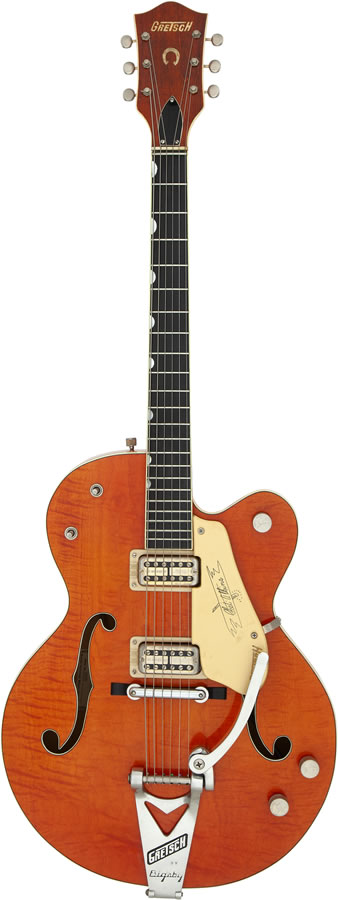
Opening bid: $25,000
From the Graham Nash Collection
Enlarge

Opening bid: $25,000
From the Graham Nash Collection
This article appears in the Spring/Summer 2019 edition of The Intelligent Collector magazine. Click here to subscribe to the print edition.

